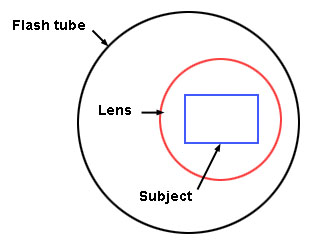The problem of sufficiently lighting the subject can be difficult to overcome in macro photography. The best lighting for macro subjects is often natural daylight. This is also the case in other fields of photography. Indeed most artificial lighting systems are designed to emulate as closely as possible natural daylight. However, when working very close to a subject is can be extremely difficult to get adequate natural light on to a subject, and shadows cast by equipment and photographer may get in the way. Many photographers use telephoto macro lenses, typically with focal lengths from about 100 to 200 mm, because they allow more space for lighting between the camera and the subject.

Flash provides an obvious answer when natural light proves insufficient. However, normal camera-mounted flashguns may well be unable to deliver the required light to a position just in front of the lens. The lens itself may even cast a shadow on to the subject. One solution is to use a ring-flash unit designed to provide uniform soft lighting over a small area. The flash tube is designed to fit around a camera lens and hence produce shadow-free lighting, but most units are fitted with a short cord which allows the unit to be positioned off-camera. When ring-flash units are used in this way the lighting is no longer shadowless and the illumination of the subject may be uneven because the tube is closer to some parts of the subject than others. A similar problem arises when a ring-flash unit with a large diameter is used off-centre around a lens to expose the flash sensor. Note also that most ring-flash units are designed for close-up work and consequently have relatively low guide numbers. At a distance of more than a few feet they may prove inadequate.
Flash used close to a subject may prove to be overwhelming or too harsh, particularly with shiny beetles and similarly reflective subjects. Flash output should be reduced where necessary, but the light can also be softened by placing a miniature softbox over the flash head. This can be achieved using something as simple as a white tissue or handkerchief.
Although flashguns are normally designed to work with shutter speeds in the range 1/60 sec to1/250 sec, this limitation is almost irrelevant when the flash unit provides most of the light for the exposure. The burst of flash lasts for only a very short period, perhaps less than one thousandth of a second, and consequently effectively freezes any motion.

Light tents are sometimes used to provide a controlled environment for small subjects where the lighting is diffused and protection from unwanted reflections is maintained. These have side and top zipped access and are normally illuminated by a pair of compact daylight fluorescent tubes positioned either side of the tent. However, the tent can also be used outside and illuminated using natural light.
Another more natural approach to lighting a macro subject is to place a table in front of a convenient north-facing window and use the natural diffused light for illumination. Hand-held or supported mirrors, and other highly reflective surfaces, can be used to fill shadows from the side furthest from the window. The advantage of the system is that it produces natural illumination and it is relatively easy to see when the lighting is correct.
Backlighting is always attractive for natural subjects such as flowers as it makes the edges of petals and leaves glow. Shots of this type are best achieved when the sun is relatively low . Position the camera so that the sun is facing the lens but slightly off to one side, and find a location where the light reveals the glow required. Then move around to a limited extent until a suitable dark or amorphous background is positioned behind the subject. Remember to expose for the subject and not the background.






